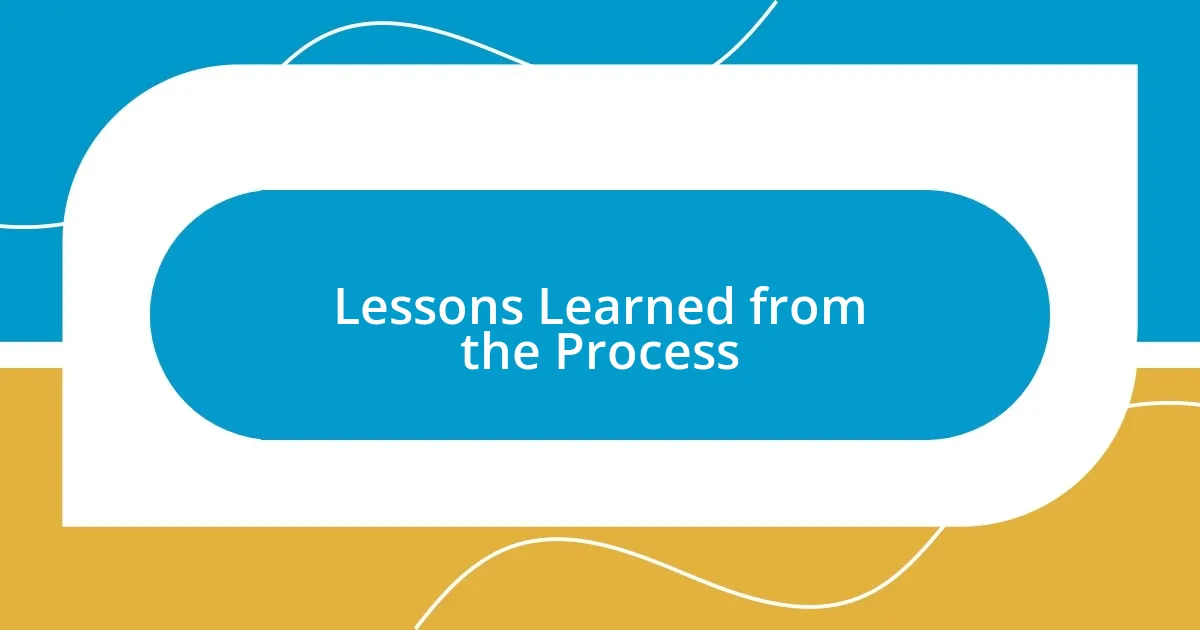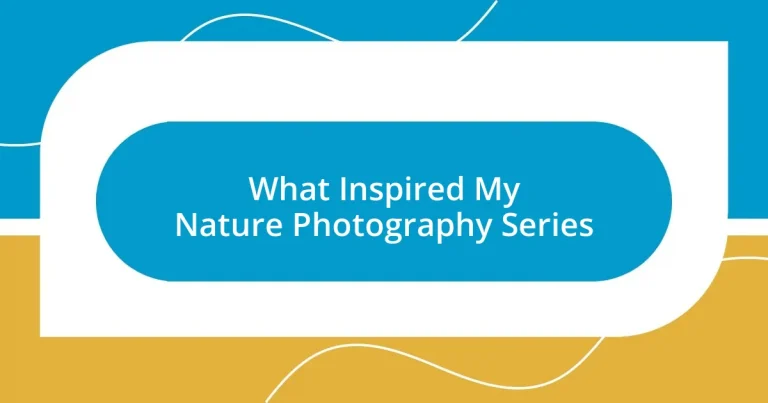Key takeaways:
- The author’s passion for nature photography began during a hike where they discovered the beauty of a hidden waterfall, sparking a desire to capture and share natural moments.
- Key techniques in nature photography include using wide-angle lenses, natural frames, and long exposure to convey emotions and create impactful imagery.
- Natural light is essential in photography, transforming ordinary scenes and affecting the mood of photographs, as demonstrated by the author’s experiences during different times of day.
- Lessons learned from the process of photography highlight the importance of patience, preparedness, and embracing the unexpected outcomes in nature.

My Journey into Nature Photography
My journey into nature photography started quite unexpectedly during a weekend hike with friends. I remember stumbling upon a hidden waterfall, the sunlight dancing through the trees, and the sound of water crashing against the rocks. That moment made me realize, how could I capture this beauty and share it with others?
As I began to explore more of the outdoors, I often found myself returning to the same spots at different times of day, fascinated by how light could transform a scene. One afternoon, I set out before dawn, hoping to catch the sunrise over a tranquil lake. The feeling of anticipation while waiting for that first burst of color was exhilarating; it was as if nature was inviting me to witness its masterpiece.
With each click of the shutter, I felt a deeper connection to my surroundings. I vividly recall the overwhelming joy I felt when I captured a fleeting moment—a deer leaping gracefully through a sunlit meadow. It struck me then: can we truly express our love for nature without safeguarding these moments for future generations? This realization became a driving force in my photography journey.

Key Influences on My Work
A significant influence on my work has been the natural world itself. I find inspiration in the smallest details—like the dew on a spider web glistening in the morning light or the intricate patterns formed by tree bark. There’s a distinct thrill in discovering beauty in the overlooked, which fuels my desire to capture these moments authentically.
- The serenity of early mornings fosters a meditative state that enhances my focus.
- Observing wildlife interactions deepens my understanding of nature’s intricate ecosystems.
- Personal experiences, like hiking trails that hold cherished memories, guide my choice of subjects.
Moreover, my travels have been transformative. Visiting national parks opened my eyes to dramatic landscapes and diverse flora and fauna. Standing before majestic mountains or vast deserts, I’ve felt an undeniable urge to translate those feelings through my lens. Each location tells a story, and I strive to convey that essence in my photographs.

Techniques for Capturing Nature
Capturing nature is not just about pointing and shooting; it’s about understanding the environment you’re in. For me, using a wide-angle lens has opened up a world of possibilities, allowing me to encapsulate sweeping landscapes that evoke a sense of grandeur. I remember one time at the Grand Canyon, where I set up my camera just as the sun began to dip below the horizon. The vibrant hues of orange and purple filled the sky, and it reminded me of how the right equipment at the right moment can transform a simple scene into a breathtaking visual story.
Another technique I cherish is the use of natural frames. When I’m out in the wilderness, I often look for elements like branches or rock formations that can serve as a frame for my subject. This approach adds depth and context to the photograph. One memorable instance was when I positioned myself behind some wildflowers, capturing a tranquil lake view beyond them. It was like peeking through a beautiful curtain, bringing the viewer right into that moment with me.
I also experiment with long exposure techniques for capturing movement, such as flowing water or swaying grass. I can’t forget that breathtaking evening at a nearby river when I set my shutter speed to several seconds. The result was a dreamlike effect that blurred the rushing water, contrasting beautifully against the solid rocks. Each technique I explore helps me to convey my emotions about nature and share the heartbeat of the wild with others.
| Technique | Description |
|---|---|
| Wide-Angle Lens | Captures expansive landscapes and emphasizes grandeur. |
| Natural Frames | Utilizes elements in the environment to add depth and context. |
| Long Exposure | Creates a sense of movement by blurring elements like water. |

Choosing the Right Equipment
When it comes to choosing the right equipment, I find that each piece tells its own story. I remember the first time I picked up a high-quality DSLR camera; it felt like a key unlocking a world of creativity. The weight of it in my hands reassured me that I could capture moments with precision and clarity, allowing me to explore textures and colors in a way that truly resonated with my vision.
Having invested in a versatile zoom lens has been a game-changer for me as well. During a trip to a serene forest, I spotted a shy deer in the distance. With this lens, I was able to zoom in and capture its delicate features without disturbing its peace. How exhilarating it was to freeze that moment in time! The lens became an extension of my eye, revealing details I would have missed otherwise.
Additionally, I often consider the role of filters in my photography. I remember a misty morning when an ND filter allowed me to create soft, ethereal images of the landscape while controlling the harsh sunlight peeking through the clouds. I find myself asking, how do we enhance our connection to nature through the tools we choose? Ultimately, the right equipment not only elevates the quality of our work but also deepens our relationship with the environments we cherish and capture.

The Importance of Natural Light
Natural light is the true painter in my photography, transforming ordinary scenes into extraordinary moments. I can’t tell you how many times I’ve been out in the early hours, waiting for the golden hour. That soft, warm light creates a magical glow on everything it touches, breathing life into my subjects. I remember capturing a quiet forest just as the sun peeked through the trees, illuminating the dew on the leaves. The scene felt alive, as if nature herself was taking a breath.
On cloudy days, natural light can have a completely different mood. I think back to a time when I roamed a misty field, and the soft overcast created a muted palette. Instead of shying away, I embraced it. The diffused light offered a gentle touch, perfect for capturing the delicate details of wildflowers. It made me wonder: why do we often overlook these less vibrant moments? There’s something incredibly powerful about the way light interacts with mood.
I’ve also learned that the position of the sun dramatically affects our photographs. During my travels, I noticed how shooting at different angles during the same day can result in vastly different emotions. One evening at a tranquil lake, the reflection of the setting sun created a shimmering path across the water. It seemed to invite viewers into a world of serenity. This made me realize that natural light isn’t just about visibility; it’s about crafting an emotional journey through visual storytelling.

Telling Stories Through Imagery
Imagery serves as a powerful narrative tool in nature photography, allowing me to convey a deeper connection to the scenes I capture. I vividly recall standing beside a rushing river, the sound of the water blending with the whispers of the trees. As I focused on the intricate patterns formed by the flowing currents, I realized that every frame I clicked wasn’t just an image but a story of resilience and life. How often do we forget the tales nature silently shares with us?
Each photograph is an invitation to explore feelings and emotions that words might struggle to express. Take, for example, a moment I encountered while hiking—a single flower defiantly growing through the cracks of a rugged rock face. The juxtaposition of delicate beauty against stark resilience spoke volumes to me and, I believe, to anyone who gazes upon that image. Isn’t it fascinating how a simple snapshot can evoke thoughts of strength and perseverance, reminding us that beauty exists even in the harshest conditions?
Moreover, I find that the stories told through imagery often resonate with our own personal experiences. When I captured the mist rolling over a mountain at dawn, it reminded me of the calm moments I cherish amid life’s chaos. Each viewer may interpret that fog differently, feeling a sense of mystery or tranquility. This interplay of perspective is what excites me—the knowledge that my images can evoke a range of emotions, inviting each person to weave their own narrative, much like a painter leaving space for the audience’s interpretation.

Lessons Learned from the Process
Throughout this journey, I’ve unearthed invaluable lessons about patience. There was a day I spent hours waiting for a bird to arrive at its nest, only to leave empty-handed. At first, I felt frustration creeping in, but then I realized that every moment spent in nature teaches us to slow down and appreciate the surroundings. It’s something I now cherish—each second, a chance to witness life unfolding.
I’ve also come to understand the significance of preparedness. On one hike, I enthusiastically set out without my usual gear, only to find the perfect composition elusive due to the failing light. It was a tough lesson, reinforcing the importance of being ready for those fleeting moments when nature decides to unveil its beauty. I often think: how can we capture those extraordinary scenes if we aren’t equipped to respond?
Lastly, I’ve learned that collaboration with nature requires a level of humility. One afternoon, while photographing a sunset, I had to accept that my vision might not always align with what was unfolding before me. In that moment, as the colors shifted unpredictably across the horizon, I realized that embracing the unexpected can lead to stunning results. Isn’t it fascinating how, sometimes, letting go of control can offer the most breathtaking surprises?














